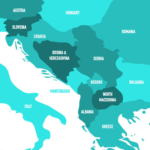On September 24, the Kosovo police reported that as a result of a clash with ethnic Serbs by the village of Banjska near Leposavic, one policeman was killed and two were injured. Later, about 30 armed Serbs broke into the monastery of the Serbian Orthodox Church in Banjska.
As a result of an anti-terrorist operation, four attackers were killed, some were detained, and some managed to escape to Serbia. Kosovo police announced that they had found documents with the arrested members of Banjska’s group linking them to Milan Radojicic, Belgrade’s key figure in northern Kosovo who has long been blacklisted by the U.S.
Milan Radojicic, the vice-president from the Serbian List, actually led the aforementioned attack by local Serbs on the Kosovo police. A new video showing Radojicic among the culprits has surfaced in Kosovo media after it was posted on social media platforms by Kosovo’s Interior Minister Xhelal Sveçla.
In this sense, the statement by Serbian President Aleksandar Vučić is quite indicative: “I warned every day, both in Brussels and in New York, that this could happen, but few wanted to hear and listen. Not people from central Serbia, but people from Kosovo and Metohija rose up, unwilling to endure Kurti’s terror anymore.”
However, now the arrest of part of the Banjska group is seen as a relative victory for Kosovo Prime Minister Kurti, and a complication – for President Vučić, who justifies his decision not to respond with force by saying that “Kurti is trying to draw Serbia into a conflict with NATO.”
In connection with the current situation, several rounds of meetings of high-ranking EU diplomats were held with the European envoy for dialogue between Belgrade and Pristina, Miroslav Lajcak, and the US special representative for the Western Balkans, Gabriel Escobar. The EU does not want to issue assessments or condemnations until the official investigation is completed and all facts are gathered.
The investigation is still ongoing and is fully run by the Kosovo Police, while EULEX and KFOR provide assistance upon request, said EC press secretary Peter Stano, who added that the EU seeks to find out who organized and who executed the terrorist attack to bring them to justice. Stano also recalled that the EULEX Mission acts on the territory of Kosovo as one of the security elements, in accordance with its mandate, and can only respond to the requests of the Kosovo police.
Meanwhile, Serbian President Aleksandar Vučić, during a meeting with the ambassadors of the U.S., Great Britain, France, Italy, and Germany, asked that KFOR deal with all security issues in northern Kosovo instead of the Kosovo police. He also wondered why the Kosovo police denied EULEX participation in the operation run in the territory of the north of Kosovo.
The U.S. Ambassador to Serbia, Christopher Hill, said the escalation of violence in Banjska, Kosovo, was a tragic incident and that further steps in response were being considered. During the operation of the Kosovo police, which searched the area around Banjska, 24 SUVs and an armored vehicle were seized. As for armaments, the published list of seized items includes eight mines, 29 loaded and seven used grenade launchers, 142 mortar mines, 75 hand grenades, as well as eight anti-tank mines; 150 packs of dynamite, 5.5 kg of explosives, 20 kg of TNT, 23 electric detonators, six machine guns, and 30 assault rifles.
Weapons could not just appear in the north of Kosovo in such great numbers so someone would have to deliver them from somewhere, and of course, all eyes are on Belgrade in this regard. Besides the origin of the weapons, the investigation should establish the organizers of the armed provocation among local Serbs. The fact that President Vučić warned of the readiness of the Serbs in the north of Kosovo to revolt does not relieve them of their responsibility. The fact that rebels from local Serbs sought refuge in the Orthodox monastery run by the Serbian Orthodox Church cannot but cause concern. Involvement of church in military clashes is truly dangerous and requires clarity on the possible ties between clerics and culprits.
Brussels and Washington are trying to react calmly so as not to add fuel to the fire. However, the Russian side expressed great concern not because someone attacked Kosovo policemen, but because some of the attackers were killed. After Western diplomats somewhat criticized the policy of the Kosovo prime minister, who actually did not support the Franco-German settlement plan, Kurti is now successfully exploiting the situation to discredit the policy of Belgrade, which could stand behind those Serb attackers.
President Vučić accused Kurti of a bloody provocation, but it was the local Serbs who plotted and executed it. A large number of concealed weapons were discovered, which again indicates the intention of the perpetrators to use them for the sake of the escalation between Belgrade and Pristina. It is possible that the scenario of the uprising was designed by the Kremlin, which is most interested in aggravating the situation in the north of Kosovo.
Moscow, which penetrated into all political pores of Serbia’s life, could be in direct contact with Radojicic or through trusted intermediaries among the pro-Russian part of Belgrade’s official circles. It is obvious that immediately after the incident, the president of Serbia held an urgent meeting with the Russian ambassador not only to garner political support, but also to learn for himself whether Russia was involved in these tragic events.
The investigation continues, several Serbian participants in the armed attack on the Kosovo police have been arrested, and they can give quite interesting testimonies. The situation has not yet gotten out of control, but it has escalated a lot. However, one should not forget a famous Prussian chancellor Otto Bismarck, who said 150 years ago: “One day the great European War will come out of some damned foolish thing in the Balkans.”



